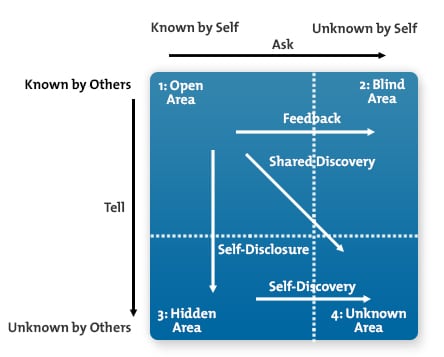To develop awareness, it’s essential to take an honest look at who you truly are. From self-awareness to self-realization to self-actualization….that is the journey of life. This is also the ultimate aim of deep coaching.
In deep coaching we are facilitating awareness at the deepest of levels, where our clients begin to sense and even experience their true nature. One of the major obstacles to experiencing that true nature is our unawareness of certain unconscious thought and habit patterns that keep us feeling separate from life and from our true source.
Here is where the Johari Window can shine some light on these unconscious areas.
The Johari Window is a communication model developed by psychologists Joseph Luft and Harrington Ingham in 1955, that can be used to improve understanding between individuals within a team or in a group setting. The main idea is that there are many things about yourself you may believe you know, but seldom do you truly know without outside input.
There are two key ideas behind the tool:
- That individuals can build trust between themselves by disclosing information about themselves; and
- That they can learn about themselves and come to terms with personal issues with the help of feedback from others.
The Johari Window is split up into four quadrants:
Quadrant #1 — What You Openly Show to Others (Public Self or The Lobby). This is the area of your personality that you share with others in varying degrees, depending upon your trust level with each individual. You feel safe and confident with this part of your personality and the information contained in this quadrant. People are welcome here.
Quadrant #2 — Only Others Know (Blind Spots or Blind Zone). Though you may not be aware, there is a part of your personality or information about you which other people know, but you do not. This quadrant holds that part of you. Such knowledge may be bad habits you do without knowing, such as the habit of biting your lip when you’re unsure of something. Knowledge in this quadrant also may be your potential (i.e. what others see in us but we don’t see in ourselves.)
Quadrant #3 — Only You Know (Hidden Self or Private Zone). This is the area of yourself that you do not wish to disclose to anyone else. It’s the very private and vulnerable part of your personality that holds your fears and doubts. It holds any embarrassing or hurtful event that you did or has happened to you. You choose very carefully whom you allow to know this part of you, if anyone at all.
Quadrant #4 —No One Knows (Unconscious Self or Unknown Zone). This area holds any knowledge and potential that you or anyone else has yet to discover. Some things from this quadrant, you will discover between now and when you leave this world. The majority of it, you will never know. The fourth quadrant also is the area where dreams are made real, where new theories are born, where new science is first thought and then discovered, and where creativity is given birth. New thought develops here. New ideas that change the world develop here. It’s the unknown part of you … the creative part of you.
We all have these four parts of Self, as shown in the Johari Window diagram, but their respective sizes vary in each of us.
By holding a deep and loving presence, we as coaches create the space where our clients begin to see those areas within themselves that have been keeping them from knowing and experiencing their true light. They also begin to access parts of their unconscious mind setting up an environment of healing and inspiration.
EXERCISES:
Exercise #1 — Who Are You, Quadrant #1: Public Self
Complete the table, using 2-3 (up to 10) words or phrases (both negative and positive) to describe each area of yourself and your personality.
Physical Appearance
Temperament (mood)
Personality
Behaviors (good/bad)
Philosophy of Life
Total Overall Person
Exercise #2 — Who Are You, Quadrant #2: Blind Spots, Part 1
Using another copy of the table, complete it again as you believe others see you.
Exercise #3 — Who Are You, Quadrant #2, Part 2 (field work)
Choose five individuals that you would like to know how they feel about you. Have them fill it out. What did others tell you about yourself that you didn’t know?
This is a great self-awareness tool for our clients that can really help shine a light on areas they may not be aware of.


